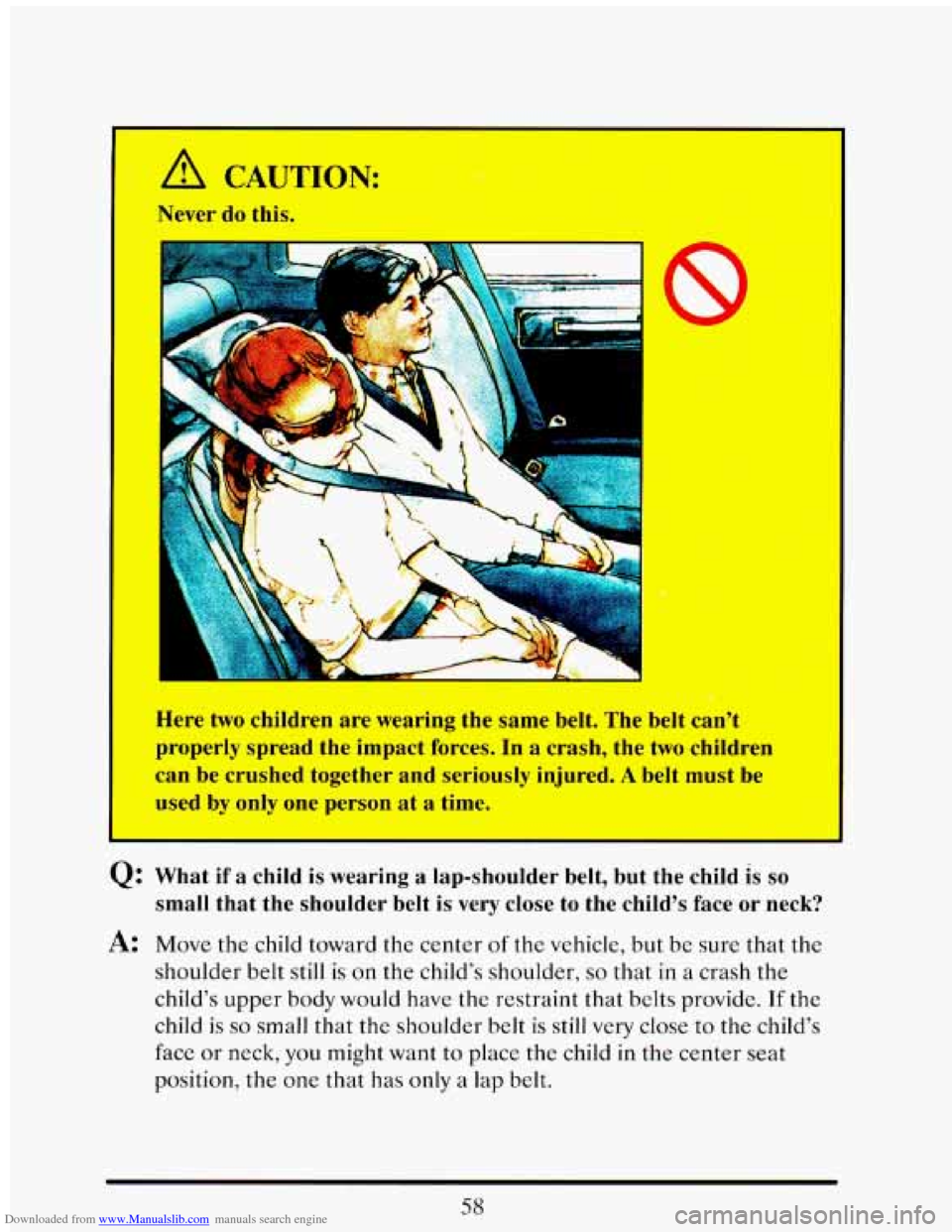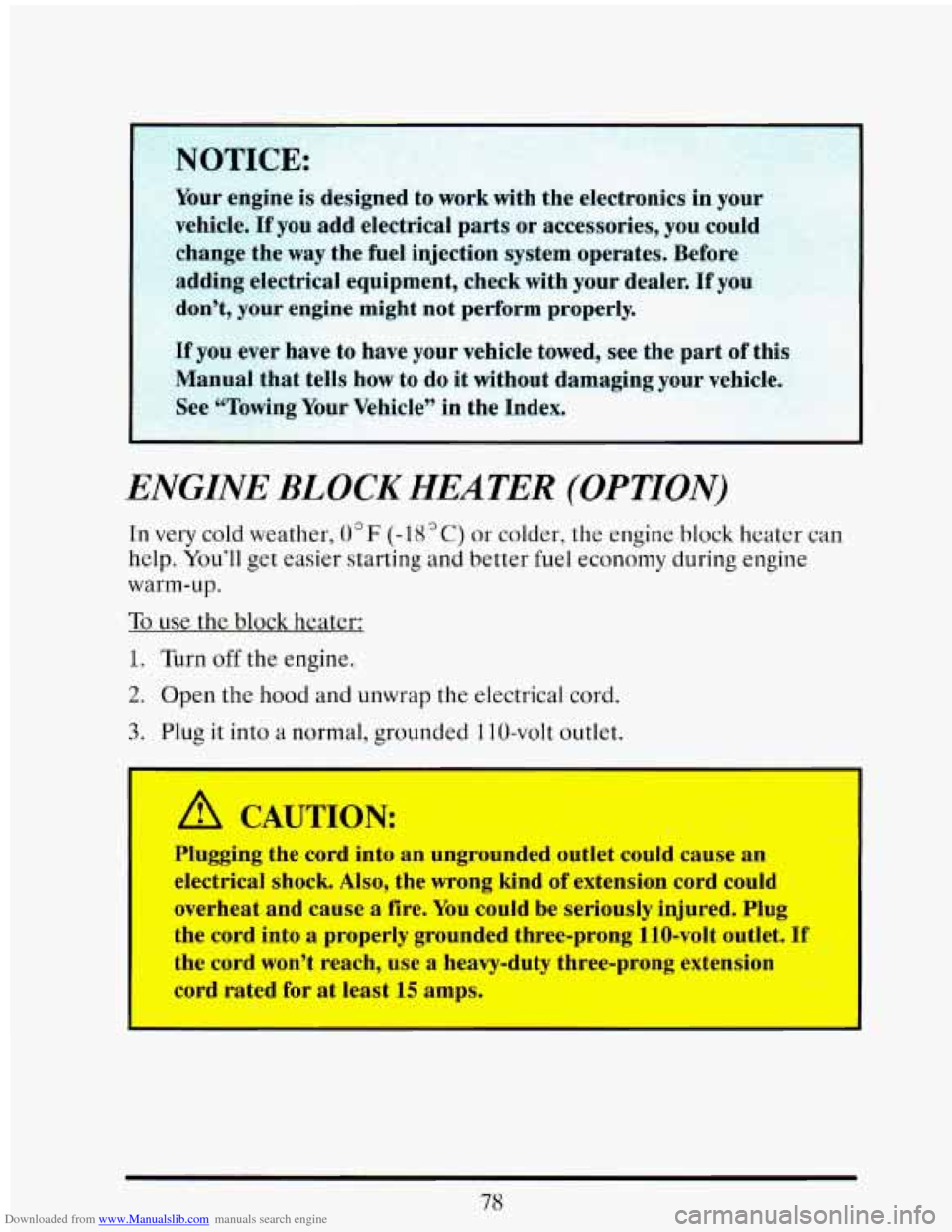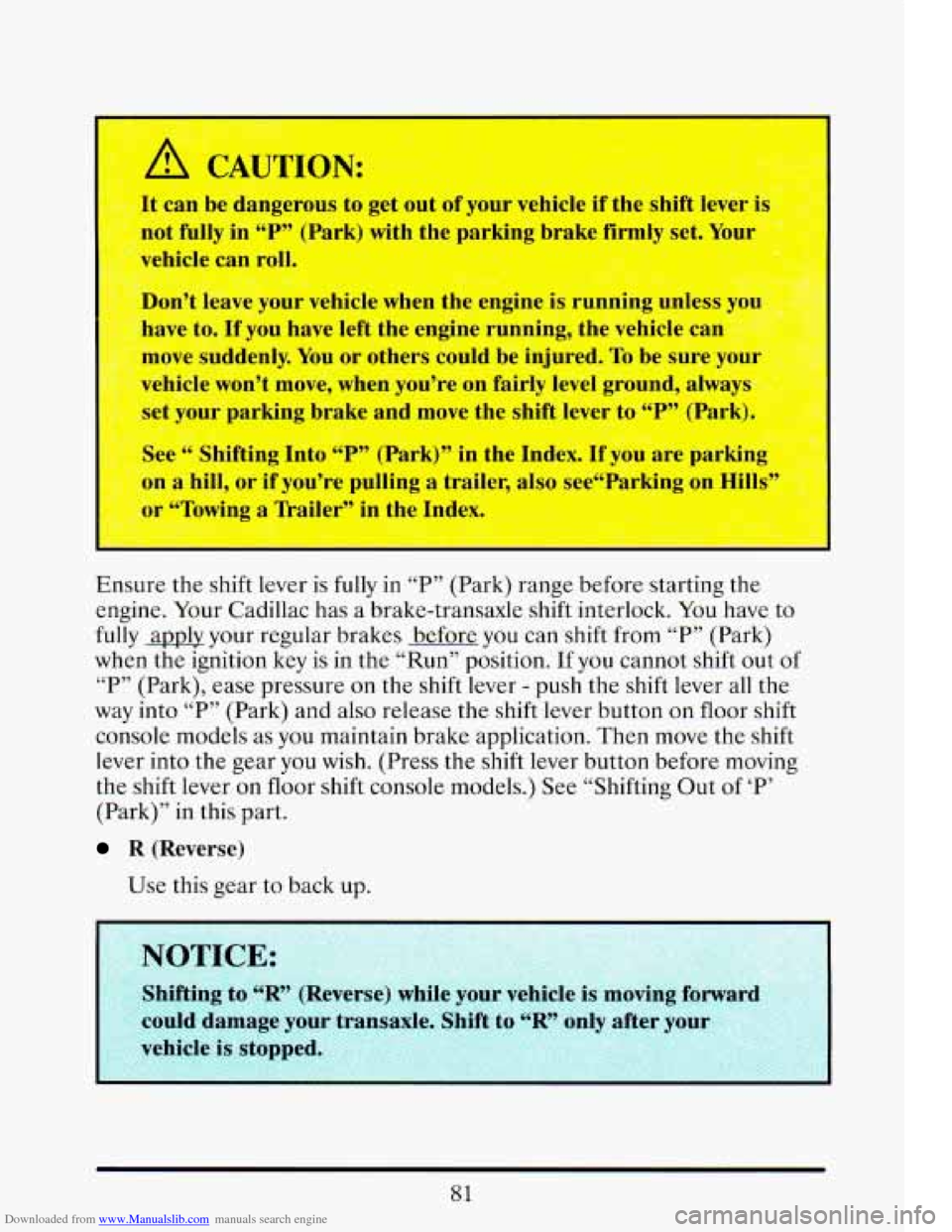1993 CADILLAC ELDORADO tow
[x] Cancel search: towPage 25 of 398

Downloaded from www.Manualslib.com manuals search engine Seatback Latches
i': . ..
The front seatback folds forward to let people get into the back seat.
Your seatback
will move back and forth freely, unless you come to a
sudden stop. Then it will lock in place.
There's one
time the seatback may not fold without some help from you.
That's
if your vchicle is parked going down a fairly steep hill.
To fold the seatback forward, push the seatback toward the rear as you
lift this latch. Then the seatback will fold forward. The latch must be
down
for the seat to work properly.
11
Page 44 of 398

Downloaded from www.Manualslib.com manuals search engine GM vehicles is between 9 and 14 mph. However, this velocity threshold
depends on the vehicle design and may be several miles-per-hour faster
or slower. In addition, this threshold velocity
will be considerably higher if
the vehicle strikes an object such as a parked car which will move and
deform
on impact. The air bag is also not designed to inflate in rollovers,
side impacts, or rear impacts where the inflation would provide
no
occupant protection benefit.
In any particular crash, the determination
of whether the air bag should
have inflated cannot be based solely on the level
of damage on the
vehicle(s). Inflation is determined by the angle
of the impact and the
vehicle’s deceleration,
of which vehicle damage is only one indication.
Repair cost is not a good indicator
of whether an air bag should have
deployed.
What makes an air bag inflate?
In a frontal or near-frontal impact of sufficient severity, sensors
strategically located
on the vehicle detect that the vehicle is suddenly
stopping as a result
of a crash. These sensors complete an electrical
circuit, triggering a chemical reaction
of the sodium azide sealed in the
inflator. The reaction produces nitrogen gas, which inflates a cloth bag.
The inflator, cloth bag, and related hardware are all part
of the air bag
inflator modules packed inside the steering wheel and in the instrument
panel in front of the passenger
if there is a passenger air bag.
How does an air bag restrain?
In moderate to severe frontal or near-frontal collisions, even belted
occupants can contact the steering wheel or the instrument pane\
l. The air
bag supplements the protection provided by safety belts. Air bags
distribute the force of the impact more evenly over the occupant’s upper
body, stopping the occupant more gradually. But air bags would not
provide protection
in many types of collisions, including rollovers and
rear and side impacts, primarily because an occupant’s motion is not
toward the air bag. Air bags should never be regarded as anything more
than a supplement to safety belt protection in moderate to severe frontal
and near-frontal collisions.
What will you see after an air bag inflation?
After the air bag has inflated, it will then quickly deflate. This occurs so
quickly that some people may not even realize that the air bag inflated.
The air bag
will not impede the driver’s vision or ability to steer the
30
Page 72 of 398

Downloaded from www.Manualslib.com manuals search engine A CAUTION:
Ne. -do tl . .
Here two children arc learing the same belt. The belt can’t
properly spread the impact forces. In
a crash, the two children
can be crushed together and seriously injured.
A belt must be
used
by only one person at a time.
Q: What if a child is wearing a lap-shoulder belt, but the child is so
small that the shoulder belt is very close to the child’s face or neck?
A: Move the child toward the center of the vehicle, but be sure that the
shoulder belt still is on the child’s shoulder,
so that in a crash the
child’s upper body would have the restraint that belts provide.
If the
child is so small that the shoulder belt is still very close to the child’s
face or neck,
you might want to place the child in the center seat
position,
the one that has only a lap belt.
58
Page 90 of 398

Downloaded from www.Manualslib.com manuals search engine The other positions let you perform these functions:
ACC: Accessory lets you use things like the radio and the windshield
wipers when the engine
is off. To get into “ACC”, push in the key and turn
it toward you. Your steering wheel will remain locked, just
as it was
before you inserted the key.
OFF This position lets you turn off the engine but still turn the steering
wheel. It doesn’t lock the steering wheel like
“Lock.” Use “Off” if you
must have your car in motion while the engine is off (for example, if your
car
is being pushed).
RUN: This
is the position for driving.
START
This starts your engine.
r
NOTICE:
If your key seems stuck in ‘ xk and you can’t turn it, be sure
it
is all the way in. If it is, then turn the steering wheel left and
right while
you turn the key hard. But turn the key only with
your hand. Using
a tool to force it could break the key or the
ignition swi’
’1. If none of this w--ks, then your vehicle 3
servi cc
STARTING YOUR ENGINE
Engines start differently. The 8th digit of your Vehicle Identification
Number
(VIN) shows the code letter or number for your engine. You will
find the VIN at the top left
of your instrument panel. (See “Vehicle
Identification Number” in the Index.) Follow the proper steps to start the
engine.
Move your shift lever to
“P” (Park) or “N” (Neutral). Your engine won’t
start in any other position
-- that’s a safety feature. To restart when you’re
already moving, use “N” (Neutral) only.
76
Page 92 of 398

Downloaded from www.Manualslib.com manuals search engine NOTICE:
Your engine is designed to work with the electronics in yo1
vehicle. If you add electrical parts or accessories, you cod
change the
way the fuel injection system operates. Before
adding electrical equipment, check with your dealer,
If you
don’t, your engine might not perform properly.
If you ever have to have your vehicle towed, see the part of this
Manual that tells
how to do it without damaging your vehicle.
See “Tnwing Your Vehicle” in the Index.
ENGINE BLOCK HEATER (OPTION)
In very cold weather, 0” F (-1 8 C) or colder, the engine block heater can
help. You’ll get easier starting and better fuel econonly during engine
warm-up.
To use the block heater:
1. Turn off the engine.
2. Open the hood and unwrap the electrical cord.
3. Plug it into a normal, grounded 1 10-volt outlet.
r
electrical shock. Also, the wrong kind of extension cord could
the cord into
a properly grounded three-prong 110-volt outlet. If
the cord won’t reach, use a heavy-duty three-prong extension
cord rated for at least
15 amps.
I overheat and cause a fire. You could be seriously injured. Plug
78
Page 95 of 398

Downloaded from www.Manualslib.com manuals search engine vel le tan roll, $2-2.~
Don’t I enicle when the engine is runnmg unles
have
to. If you have left the engine running, the vehicle ca
move suddenly.
You or others could be injured. To be sure
vehicle won’t move, when you’re on
fairly level ground, alw
set your parking brake and move the shift lever to
“P” (Par
See “ snifting Into “P” (Park)” in the Index. 11 you are par
L a hill, or if you’re pulling a trailer, also see“Parking o
or “Towing a Trailer” in the Index.
-*- aq .: : - - . .. .h i-” .. .i T
..
Ensure the shift lever is fully in “P” (Park) range before starting the
engine. Your Cadillac has a brake-transaxle shift interlock. You have to
fully apply your regular brakes before
you can shift from “P” (Park)
when the ignition key is in the “Run” position.
If you cannot shift out of
“P” (Park), ease pressure on the shift lever - push the shift lever all the
way into “P” (Park) and also release the shift lever button on floor shift
console models as you maintain brake application. Then move the shift
lever into the gear you wish. (Press the shift lever button before moving
the shift lever
on floor shift console models.) See “Shifting Out of ‘P’
(Park)” in this part.
R (Reverse)
Use this gear to back up.
81
Page 96 of 398

Downloaded from www.Manualslib.com manuals search engine To rock your vehicle back and forth to get out of snow, ice or sand
without damaging your transaxle, see “If You’re Stuck in Sand, Mud, Ice
or
Snow” in the Index.
N (Neutral)
In this position, your engine doesn’t connect with the wheels. To
restart when you’re already moving, use “N” (Neutral) only. Also, use
“N” when your vehicle is being towed.
A CAUTION:
Shifting out of “P” (Park) or “N” (Neutral) while your engine is
“racing” (running at high speed) is dangerous. Unless your foot
is firmly
on the brake pedal, your vehicle could move very
rapidly. You could lose control and hit people or objects. Don’t
shift out of
“P” (Park) or “N” (Neutral) while your engine is
racing.
Damage to your transaxle caused by shifting out of
“P” (Park
L
0 @ Automatic Overdrive
This position is
for normal driving. If you need more power for
passing, and you’re:
Going less than about
35 mph (56 km/h), push your accelerator
pedal about halfway down.
Going about
35 mph (56 km/h) or more, push the accelerator all
the
way down.
You’ll shift down to the next gear and have more power.
82
Page 97 of 398

Downloaded from www.Manualslib.com manuals search engine L NOTIW:
3 (Third Gear)
This is like
@ , but you never go into Overdrive.
Here are some times you might choose
“ 3 ” instead of @:
- When driving on hilly, winding roads
- When towing a trailer, so there is less shifting between gears
- When going down a steep hill
2 (Second Gear)
This position gives you more power but lower fuel economy. You can
use
“2” on hills. It can help control your speed as you go down steep
mountain roads, but then you would also want to use your brakes
off
and on.
nlh
83